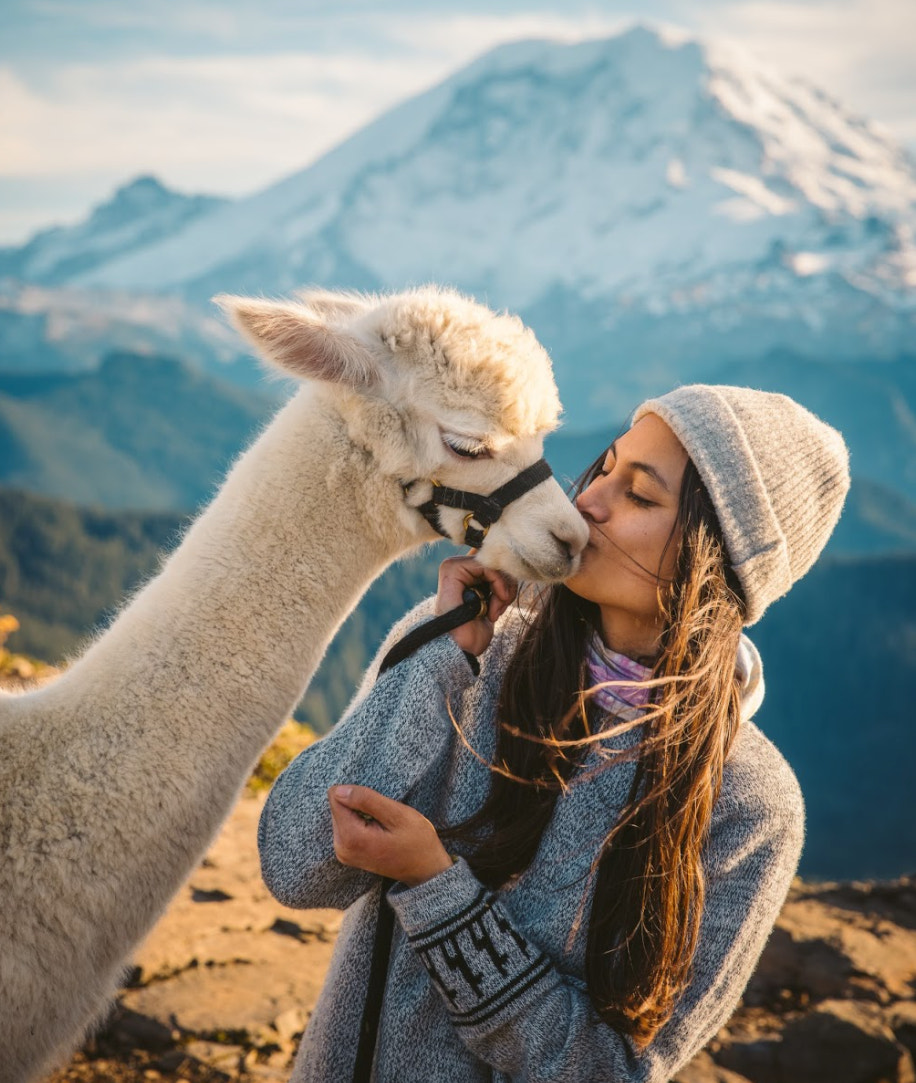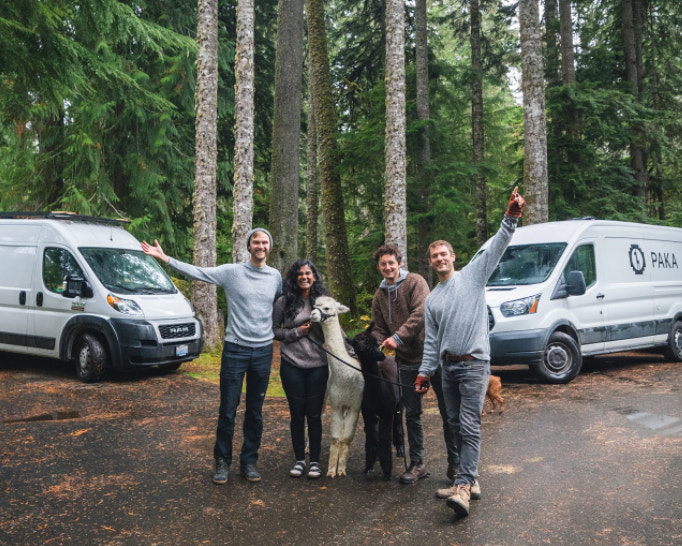Above: The leading ladies of Paka, Chaska (left) and Luna (right).
软的、可持续的和最func之一tional materials in existence with rich cultural symbolism? Alpaca fur. Yup, that's right.
Kris Cody, the founder of Paka apparel, and his two gorgeous alpacas, Luna and Chaska, joined me for a chat about all things business, community, andsustainability.
I learned all about their role in making some of the softest, most sustainable clothing on the planet, as well as how Paka is inspiring people to get curious about where and how its clothing is made and the brand’s unique way of crossing in-person connection and online fulfillment.
Subscribe to Retail Radar
Get more Retailer Stories in your inbox
Unsubscribe anytime
Following curiosity in the Andes Mountains
The story of Paka starts with a backpacking trip through Peru. Before heading off to college in 2015, Kris took a trip to see the Andes Mountains, not realizing he’d return home to the United States with a life-changing business idea.
While exploring Peru, Kris came across a hand-woven sweater that a local weaver had made out of alpaca fur. He purchased the sweater and when he returned home was subsequently asked by several people where he got it and how they could buy one too.
According toOxford Academic, when synthetic clothing is washed, microfibers—or pieces of plastic less than 1mm in diameter—are released, making their way into major bodies of water, and eventually, the air we breathe, and the food we eat.
Pesticides and other chemicalslatch onto microfibers, and as a result, have a profoundly negative impact on the environment as well as plant, animal, and human life. What’s more, according to the Ellen McArthur Foundation, humans waste enough clothing to fill1½ Empire State Buildingsevery day.
Those are harrowing statistics. A self-proclaimed nature lover, Cody saw an opportunity to reduce microfiber waste by creating that same sweater he purchased during his first trip to Peru.
Inspired to explore this idea further, he booked a one-way ticket back to Peru to immerse himself in Quechuan culture and the sacred practice of weaving garments with alpaca fur. As he built connections with locals and learned more about alpaca fur’s uniqueness, it became apparent he could create far more than just a clothing line.
“There was nobusiness plan, there was no foresight at all. A lot of it was formulated before we even started creating anything,” says Cody. “It was more of an exploration into this curiosity of, like, ‘What is this? Where is it from?’ How can we build this together in a way that’s done ethically and right?”
"There was no business plan... It was more of an exploration into this curiosity... ‘What is this? Where is it from?’ How can we build this together in a way that’s done ethically and right?"
Cody assembled a team of Quechua female weavers to make the sweaters (and eventually other products, like socks and joggers) in a sustainable, ethical way.
Related Stories:
- How This California Pair Built a High-End Surf Brand With Upcycled Wood Scraps
- How One Design Duo Went From Kickstarter Campaigns to a Successful Pop-Up Shop
- How This Jewelry Brand Is Making An Impact, One Accessory At A Time
- Vegan Skincare: Turning Acne Treatments Into a Booming Natural Beauty Business
A product with a built-in story
How’s this for a cool fact: alpaca fur is not only super soft, it’s also a “smart” fiber, meaning it keeps the animal warm at night and cool during the day. Plus, it’s warmer than sheep’s wool and has moisture-wicking properties.
That’s a recipe for a stellar sweater, IMO.
Kris launched a few prototypes out of his college dorm using a simple Shopify storefront and received a small yet positive response.
The following weeks were spent on initiatives like handwriting thank-you notes to anyone who purchased a sweater and sneaking backstage at concerts to try to reach artists with large platforms to help spread the word about Paka.

Chaska and Priya stroll through the Olympic Peninsula. Photo by Michael Matti.
“It’s not about clothing. It’s about showing people the root of where their things come from,” says Kris. “It’s the same reason I bought that one-way ticket—curiosity. Like, Where does stuff come from? Where does the food that you’re buying come from?”
"It’s not about clothing. It’s about showing people the root of where their things come from."
接下来的夏天,Paka发起KickstarterOB欧宝娱乐APPcampaign, complete with a video showcasing the brand. Within 30 days, the campaign raised $350k—all without advertising or any other paid methods.
After the campaign ended, “I had to drop out of college and head down to Peru to scale our team of women weavers to over 30 and start to really build,” says Kris. “And so we built a lot of functional, minimal—not “fashion”—apparel out of the quality of this fiber that evolved in the Andes Mountains.”
However, the planet isn’t the only thing that benefits from thesustainable clothingmovement. Paka aims toincrease each of its Quechua weaver’s daily income by 8x, which has a resounding impact on their families, communities, and lives.
Building community in a socially distanced world
In 2020, the Troy, Virginia-based Paka team hit the road along the West Coast with their two baby female Huacaya alpacas, Luna and Chaska. Their goal with the tour was to share the Paka story with people and encourage them to think more sustainably about where they purchase clothing.
“One thing that I really love and have fallen into is branding. You know, creating a community of people that know where their things come from,” says Kris. “That’s why I’m on tour—to meet people and to have this offline connection with people where they really get to know the story of the brand and, again, ignite that curiosity.”
The Paka team has made appearances at farmers’ markets and REI stores and has even hosted alpaca yoga (how awesome does alpaca yoga sound?!) with Luna and Chaska. But the alpacas themselves, Kris says, are the real catalyst forcommunity building.

Chaska and Seattle-Based Photographer, Alex Ford, get cozy. Photo by Kyle Kotajarvi
“Up until this point, with Instagram growth, I was all about hitting up influencers to take photos in the clothing. That was really the only way to thread Paka in terms of how I visualized it,” says Kris. “It’s not about the clothing so much as it’s about going on a hike with the alpacas. It’s allowed for a lot more organic conversations as opposed to pushing our products.”
"It’s allowed for a lot more organic conversations as opposed to pushing our products."
The alpacas create a visceral experience for customers and encourage them to learn more about the brand.
There’s been a lot of buzz over the last few years (especially this year) about whether retail is dead or not. Paka is a prime example of why retail won’t ever go away; the visceral connection between customers and brands will never not be important. It just may look different in its execution.
However, Cody and the Paka team want to share more than just their brand—they want to find ways to foster a community built on shared values:sustainability and ethical consumption.
They’ve also launched initiatives like educational email series and abrand ambassador programto further their reach.
Driving online sales while on the road
This type of community outreach has proven to be wildly successful for the brand. But how does the Paka team deal with lugging around inventory while on tour?
The answer is simple: they don’t.
Kris and his team knew from the start that they didn’t want to travel with stock. They wanted to focus on building their community and brand awareness, with Luna and Chaska at the forefront. So customers are encouraged to place their orders online throughPaka’s Shopify storefront.
Taking things a step further, Paka hands out $20 gift cards to customers they meet on tour. The cards are made of wood and include wash instructions—sustainable and educational!
Though the gift cards aren’t the biggest revenue generator, they help build a die-hard community that is super engaged and loves the brand, which leads to conversions.

All smiles in the Olympic Peninsula forest during Paka’s 2020 tour along the West Coast. Photo by Michael Matti.
This is an excellent example of the magic ofexperiential retail, albeit a small example, which is especially important due to current limitations on how many people are allowed inside stores.
Through this tour and its different elements—the alpacas, the socially distanced events, the gift cards—Paka, now a Certified B Corp, can bring its brand experience to life.
Resiliency in every fiber
The future may be uncertain for Paka, but that’s not due to a lack of passion or vision. COVID-19 has forced Cody and his team to pivot, like so many other retailers.
One thing’s certain: Paka will continue to encourage people to get curious about where they shop and how their clothes are made.
"Resilience means doing things for your community, putting the team on your back, and doing what you can for people."
“COVID has forced people to really look at what matters in their life,” says Kris. “Resilience means doing things for your community, putting the team on your back, and doing what you can for people.”
Try Shopify POS for in-person selling
Get all the tools you need to manage your online and physical stores, market to customers, accept payments, and sell everywhere from the same place.

